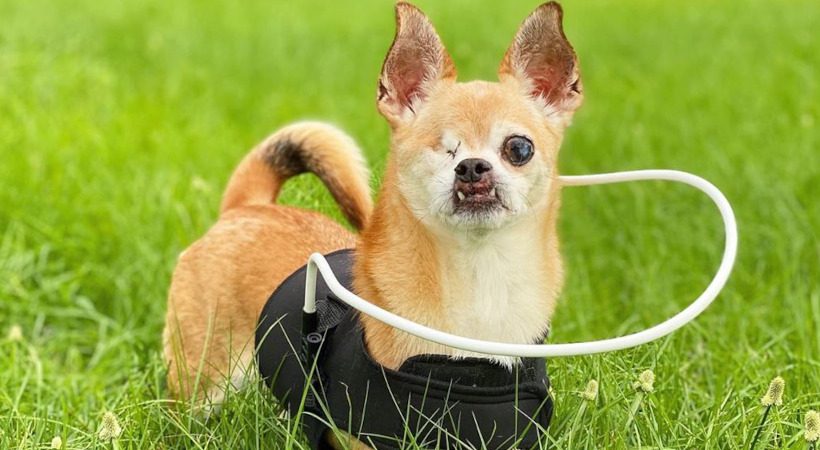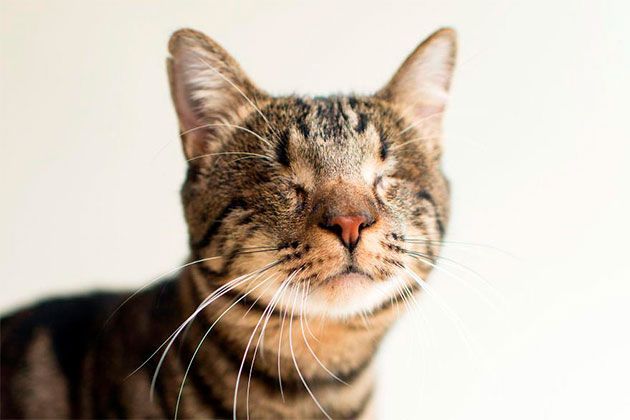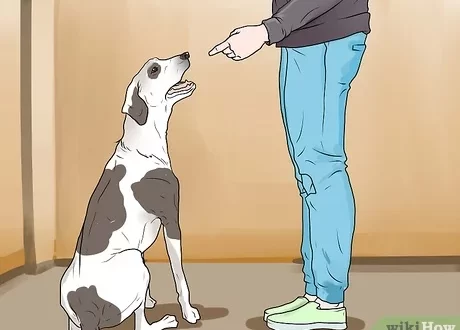
Слеп милениче

Blindness or partial vision loss is not uncommon among pets – cats and dogs. Blindness can be congenital and acquired, affecting one or both eyes, associated with systemic diseases. How to improve the life of a pet who cannot see?
Signs of blindness
It can be difficult for the owner to determine blindness in a pet, especially in a cat, if there are no visual changes in the structures of the eye, since cats can navigate well in a familiar environment through hearing, touch, and long vibrissae (whiskers) help them well. In dogs, signs of visual loss are usually more pronounced, but dogs rely on hearing and smell.
- The animal stumbles upon objects in the apartment, stumbles over obstacles
- Doesn’t notice a thrown toy
- Pays no attention to the movements of the owners
- May become aggressive or vice versa more shy and cautious, reacts sharply to sudden touches or walking nearby
- On a walk, he may not notice obstacles, not react to other people and animals
- Visual impairment is often noticeable at night, animals are less oriented and more likely to be frightened
- With eye diseases, darkening, redness, clouding of the structures of the eye, the formation of bulges or ulcers on the surface of the cornea, a change in the shape of the pupil or the pupil stops responding to lighting, an increase in the size of the eyeball, displacement of the eye from the orbit, with microphthalmos and anophthalmos, the eyeball is underdeveloped or absent at all.
The causes of congenital pathologies can be intrauterine developmental disorders, diseases transferred by the mother, hereditary and genetic factors. Causes of acquired vision loss:
- Infections (canine distemper, canine adenovirus, feline herpesvirus, calicivirus, feline infectious peritonitis, feline immunodeficiency virus, conjunctivitis)
- Кератитис
- глауком
- Катаракта
- Неоплазми
- Systemic causes of vision loss include diabetes mellitus or chronic renal failure.
- Повреди
- Невролошки патологии
дијагностика
Diagnosis should be taken seriously. A timely visit to an ophthalmologist can help maintain or restore vision. In some situations, however, you will need to consult a veterinary neurologist or therapist.
- The examination of the animal is carried out completely, and not only the visual apparatus is checked
- The doctor checks with special tests whether there is vision or not
- Registers whether there is a reaction to bright light, the eyelids should close
- Inspection of the structures of the eye with an ophthalmoscope and a slit lamp
- If visualization is difficult, then an ultrasound of the eyes is performed.
- Washings from the conjunctiva for infectious diseases
- Tests with fluorescein and others
- Blood tests may be required to exclude systemic diseases
- Sometimes an MRI of the head is needed.
третман
With congenital severe eye pathologies, treatment will be powerless. The same applies to advanced cases and severe injuries. In other situations, surgical or therapeutic treatment can be used. Today, for example, operations to replace the lens are successfully carried out. As for systemic diseases, they must be taken under control so that the condition of vision does not worsen. In the case of neurological problems, vision can return when the underlying pathology is eliminated. Infectious diseases must also be controlled, otherwise panophthalmitis may develop and the eye will have to be removed. For the treatment of infectious diseases, local and systemic treatment is used.
Features of blind dogs and cats
A blind animal usually navigates well in the familiar environment of the house and on the site, they move freely, can run and jump on furniture, find toys by sound and smell, distinguish people by smell and voice. Especially if it does not see from birth or early childhood, and does not know other ways of orienting. It is not recommended to rearrange the furniture so that the pet does not injure itself, and if a new object appears, the animal should be shown it so that it does not come as a surprise to him. If, however, it is difficult for the animal or you have recently adopted a blind pet, then you can use special soft tapes, corners, protective gates that are used for the safety of children for protection. In no case should you sharply touch a blind animal, it can get scared and bite, or break away and injure itself. First you need to call the pet by name, stomp your foot on the floor so that he knows that someone is nearby. Blind animals, as a rule, do not always adequately perceive other unfamiliar animals, not seeing their body signals, but, nevertheless, they may well get used to a new animal in the house. In some cases, a sighted animal even helps its blind companion, for example, a blind dog is more likely to go for a walk in a yard with a sighted dog with which he is on good terms. Образование и обука. Basically, the animal is guided by voice commands, listens to the intonation of the owner, the same phrase “yes!” can sound like a marker for a correctly executed command. or “okay”, clicker or whistle signal. Additionally, you can use an electric collar with a vibration and sound function, linking its signal with any action or command. Both cats and dogs need to be played, they play and catch objects by ear, and they love to play very much, with a cat for joint games you can use teasing rods, soft and fur mice; for dogs – ropes, soft toys. For independent games, toys that make sounds or have smells are suitable for a pet – with squeakers and bells, crunchy and rustling toys, toys with catnip or sound chips, ball tracks, toys for treats. There is no need to feel sorry for the animal and carry it constantly in your arms, to fence it off from communication, walks and games, as it becomes harder for it to navigate in space. Blind dogs also learn commands well, especially if they are associated with the position of their body in space (sit, lie down, bunny) or with touching a person (paw, touch). Do not change the usual course of things, do not rearrange the bowls, tray, beds and houses, a box of toys: blind animals have difficulty accepting changes. There are also special frames that can be attached to the harness, replacing the animal with a cane and preventing the animal from hitting obstacles with its muzzle. It is convenient to use such a frame when walking with a dog, especially a young and active one. Cats move more carefully, and within the apartment, such a frame can only interfere more often.





